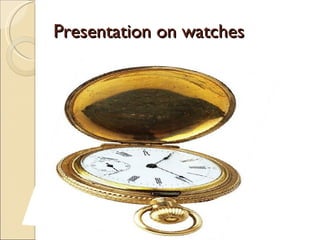Watches Verticals Students Submissions
- 2. Introduction of Watch Have you ever felt charmed with watch When you saw its image in a magazine or on a website? These wonderful watch images are made with a combination of good equipment as well as Proper techniques both during the shoot as well as post processing
- 3. HISTORY Time is considered one of our most valuable assets. It is said that one of the first watches was created in Italy around 1524 CE. Timepieces of that era were typically driven by weights making it very difficult for portable use. It was then a second hand was added to the watch.
- 4. What is watch A watch is a timepiece that is made to be worn on a person. The term now usually refers to a wristwatch , which is worn on the wrist with a strap or bracelet. In addition to the time, modern watches often display the day, date, month and year, and electronic watches may have many other functions.
- 5. TYPES OF WATCH MAINLY IT IS DIVIDED INTO TWO TYPES:- MENŌĆÖS TYPE WOMENŌĆÖS TYPE BOTH ARE FURTHER DIVIDED INTO FOUR TYPES:- CASUAL WATCHES DRESS WATCHES SPORTS WATCHES STOPWACHES
- 6. Big Players Titan Omaxe HMT Timex Swiss
- 7. ╠²
- 8. Inventor of watch Filing date : 14 Jan 1972 Issue date : Jul 1973 Inventor : John M. Bergey Assignee : HMW Industries
- 9. Types of Display in watches Analog:- Traditionally, watches have displayed the time in analog form, with a numbered dial upon which are mounted at least a rotating hour hand and a longer, rotating minute hand. Digital:- A digital display simply shows the time as a number, e.g., 12:40 instead of a short hand pointing towards the number 12 and a long hand pointing towards the number 8 on a dial. Some watches, such as the Timex Datalink USB, feature dot matrix displays.
- 10. Functions of watch Timepieces alarms striking mechanisms or repeater functions, timepieces. Complication. the chronograph complication, which is the ability of the watch movement to function as a stopwatch, lunar phase Tourbillion Perpetual calendar Minute repeater, Equation of time Stopwatch chronometer watch has a high quality mechanical or a thermo-compensated quartz movement that has been tested and certified to operate within a certain standard of accuracy by the COSC (Contr├┤le Officiel Suisse des Chronom├©tres).
- 11. Thanks Majid Ali










